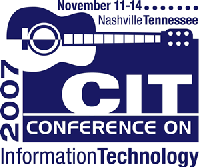
A interesting presentation on the premises raised in Thomas L. Friedman's book "
The World is Flat - A Brief History Of The Twenty-First Century" and their implications for education. The first part of the presentation dealt with some of the issues facing educators teaching in this new world and the second part of the presentation dealt with the learners learning in this new world.
The global competitive landscape has ben flattened and restructured - in other words the world is smaller, communications and information flow is faster and we live in a 24/7 world - much of the work we do now can be done in other places in other time zones while we sleep.
Here is what has happened:
- Empowerment
- Less hierarchy
- Widely distributed knowledge
- Course-based learning is unable to meet needs
It's the last point that has the biggest impact on me as an educator. If course-based learning isn't working, what do we need to replace it with?
The learning found in traditional course-based learning is now being found in all sorts of places, supported by tools and technologies that include:
- Aggregators - RSS
- Webware
- Blogging (everyone should be blogging)
- MMORPGs (World of Warcraft, Second Life)
One of the natures of these tools is that they tend to blur into each other - so expect some level of confusion and chaos with the use of these tools - but they are the tools of the millennial or net-gen learners.
Presenters compared the 21st century communications revolution as having the same impact as the Industrial Revolution did, and I think they have a valid point. The NCTT (
National Center for Telecommunications Technologies) is a great resource linking the ICT industry and education - lots of resources and information on how changes in ICT will and are influencing education.
Bandwidth technologies and access to high speed bandwidth are being driven by several things including:
- Webware
- Online Gaming
- Video/IPTV
- MMORPGs
- Social Networking
It's access to bandwidth athat will impact education - without sufficient bandwidth, much of the tools and technologies we want to use in education will not be readily or universally accessible - this will be an issue for educators. Bandwidth is expanding, with research being done that has reached speeds of 20 megabits/second - unfortunately there are still large parts of North America (and much of the world) with dial-up or no connectivity. This will take a joint effort from ICT firms and educational institutions working together to fix.
As educators we need to understand the neo-millennial learners, have a "secret sauce" that will attract, engage, and retain learners and we need to understand the implications of the flattened world for education and learning.
Here are some of the implications of the flattened world:
- The worldis less predictable and hierarchical - undergoing rapid change with widely distributed knowledge - classroom learning is strating to fail
- Informal learning on the rise along with new technologies and forms of learning - learning is becoming indistinguishable from work
- Changing demographics require different learning approaches
There is a paradigm shift occurring in learning:
From To
Formal Training Informal Learning
Management Driven Learner Empowered
Centralized Decentralized
Instructor Driven Subject Matter Expert Empowered
Pedagogy/Instruction Collaboration
When Available When Needed
Individuals Communities
Organizational Trans-Organizational
Lifetime Employment Lifetime Employbility
Mobility is the steroids that are moving everything. Web 2.0 has brought many to many publishing, web apps, workflow driven team collaboration - on the mobile web information must be delivered seamlessly regardless of the device (
Sir Tim Berners=Lee) - this is a major implication for learners and educators as more and more will use mobile devices and not computers to connect to the Web and access information and learning. we are seeing peer to peer communication through shared information.
So what should our learners look like? Here are some essential characteristics:
- Life long learning
- Able to navigate and evaluate information - information literacy
- Not about intelligence - it's about curiosity and passion
- Well rounded and creative (Sir Ken Robinson) - creativity should be a basic skill
And there are some challenges facing us as well:
- Numbers - not enough people
- Education at the top
- Ambition
- Education at the bottom
- Funding
- Infrastructure
These challenges can be met in many ways by realizing that the world is flat and that we must look at and adopt the new tools and technologies available to us and our learners - meet them where they are - learners now have a disposable life - this influences attitudes and engagement.
Mobility will be the driver - right now the iPhone is the best mobile device, but is about to get serious competition from the Google Phone (about $200 US). whatever device is used - it will all be about moile learning.
A great presentation highlighting ofr me what have become the major themes of CIT 2007 - mobility, learning, engagement and the paradigm shifts that are resulting in a whole new way to learn and educate...














 I'm leaving later today for Nashville where I will be attending the
I'm leaving later today for Nashville where I will be attending the  Wednesday night I attended the ITANS (
Wednesday night I attended the ITANS ( This whole blogging thing may just be here to stay :-). I've been blogging seriously now for a couple of years and I have friends like
This whole blogging thing may just be here to stay :-). I've been blogging seriously now for a couple of years and I have friends like  Noel, or more correctly post-tropical storm Noel blew through here last night. Lots of wind and rain and the obligatory power outage. It seems these days it's a given that if it gets windy several things happen - generator, battery, and water sales goes up, and confidence in the power company goes way down. Having said that I'd like to thanks the power crews that venture out in the wind and rain to repair the outages - they have my admiration and thanks. I watch the Powerline Technicians climbing poles at the college during good weather - I can only imagine what it's like in a near hurricane.
Noel, or more correctly post-tropical storm Noel blew through here last night. Lots of wind and rain and the obligatory power outage. It seems these days it's a given that if it gets windy several things happen - generator, battery, and water sales goes up, and confidence in the power company goes way down. Having said that I'd like to thanks the power crews that venture out in the wind and rain to repair the outages - they have my admiration and thanks. I watch the Powerline Technicians climbing poles at the college during good weather - I can only imagine what it's like in a near hurricane. An interesting post at The
An interesting post at The 
